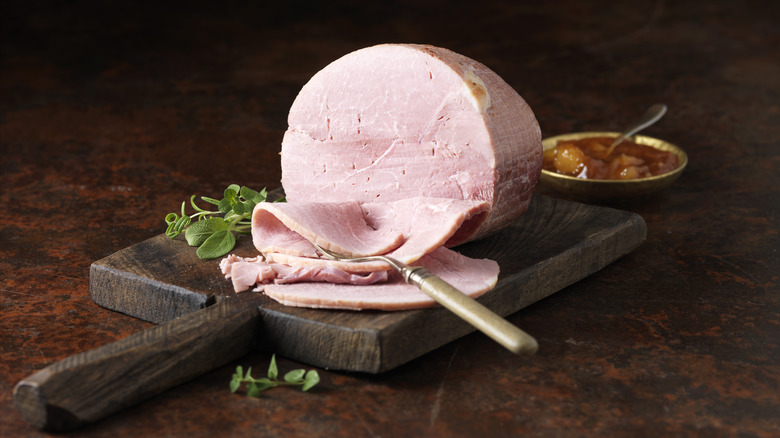What Makes Uncured Ham Different From Its Cured Counterpart?
Ham is America's top deli meat product, with more than 170 million consumers across the country (according to research from Statista). It is commonly sliced thinly for ham and cheese sandwiches, diced into salads or pasta, or glazed with honey mustard for Easter and other family gatherings.
A staple in many cultures and homes, ham can be either cured or uncured. Both types of ham come from the same cut of pork — the leg — which means they have a similar texture and flavor. They can be prepared using various methods, with baking, grilling, and roasting being the most popular choices.
The key difference between the two lies in their preservation methods. However, each type technically undergoes a curing process. With that in mind, how does uncured ham differ from its cured alternative? Well, cured ham is preserved using salts and nitrates, which enhance the flavor and extend the shelf life. Alternatively, uncured ham relies on natural ingredients like sea salt and celery powder for preservation.
How cured ham is made
Curing as a preservation technique dates back to ancient times, with its earliest form being dehydration. Ancient Asian civilizations were among the first to dry foods around 12,000 BC, discovering that removing moisture from food prevents bacterial growth and extends storage life. However, the credit for developing the method for curing ham as early as the 5th century BC, goes to the Etruscans, a culture recognized as the first advanced civilization in Italy.
Cured ham is typically processed with salt, nitrates, and other flavorings. Salt is the primary ingredient, while nitrates (usually sodium nitrate) play a crucial role in preventing spoilage and enhancing the meat's color to a pink or deep rose. There are two main curing techniques: wet curing and dry curing.
Wet curing involves soaking the ham in brine, which is a highly concentrated solution of water and common salt (sodium chloride). The brine includes spices, brown sugar, and synthetic nitrates to enhance flavor and preservation. During the process, which usually lasts up to seven days, a day for every pound of meat, the ham absorbs both moisture and flavors. Dry-curing, on the other hand, involves rubbing the ham with a blend of salt, spices, and sodium nitrite before allowing it to sit at room temperature.
The method is often frowned upon by experts. The World Health Organization (WHO) has found evidence linking cured meats to cancer, as indicated by many animal studies.
Is uncured ham better?
Unlike its counterpart, uncured ham does not undergo treatment with synthetic sodium nitrate, which is what truly distinguishes it from cured ham. However, all ham is technically cured, and even uncured ham undergoes its own curing process. The difference is, the treatment is slightly more natural and includes sea salt, celery powder, and sometimes even beet extracts.
Celery is essential in the ham's treatment as it is rich in natural nitrates, which later convert to nitrites during fermentation. These improve the meat's color, texture, and flavor, but without artificial preservatives, the meat can end up being a bit lighter in color with a different flavor profile.
After being rubbed with the mixture, the ham is soaked in wet brine before being smoked or cooked. This can take anywhere from a few days to several weeks, with the duration being influenced by environmental factors such as temperature and humidity.
But, while some argue that uncured ham is a healthier option (as the vitamin C in vegetables used for curing inhibits the formation of nitrosamines and lowers the risk of cancer), scientists at Harvard have a different opinion. Our bodies, it seems, can't distinguish between the two, as both types convert to nitrites. These subsequently interact with specific components found in meat to form cancerogenic N-nitroso compounds in the stomach's acidic environment.


